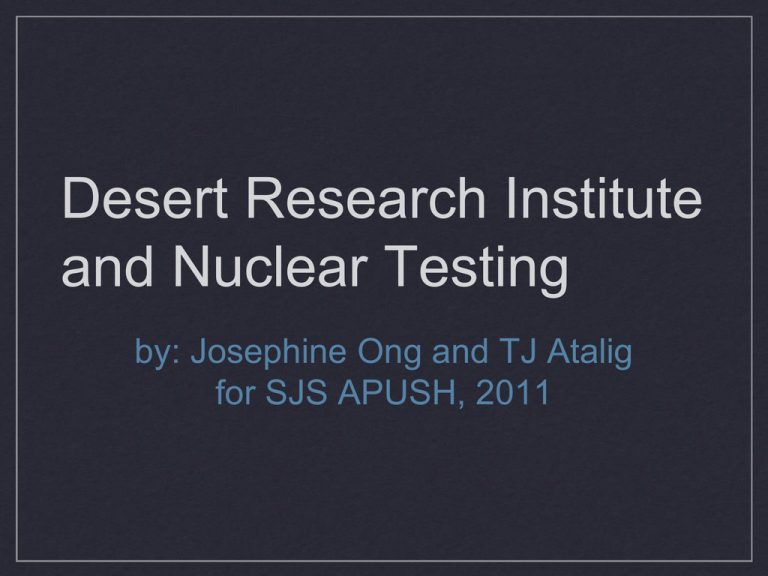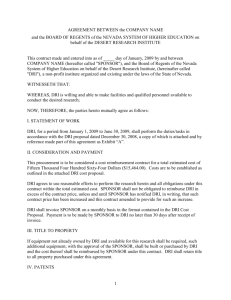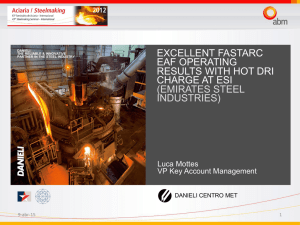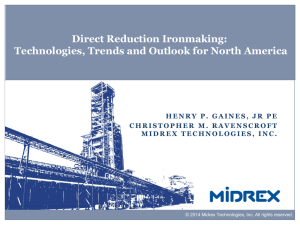Desert Research Institute and Nuclear Testing
advertisement

Desert Research Institute and Nuclear Testing by: Josephine Ong and TJ Atalig for SJS APUSH, 2011 The Cold War • What is Nuclear Testing? • It is basically experiments that would test for nuclear weapon, like the atomic bomb. (A-bomb) • Would test how the weapons work, reactions under different conditions, and also the effect of the weapon on the people or objects exposed to it. The Cold War United States vs. Russia United States: • Did not want to share nuclear secrets because if gave them power. Russia may have had the Red Army but the Americans had the most destructive weapon in the world. • Had more nuclear weapons • Had already shown the world through japan. The Cold War Russia: • Had the second most nuclear weapons behind America. • Have not yet shown the world their weapons. • Believed that the Americans were practicing atomic diplomacy. Which is maintaining nuclear monopoly to scare the soviets into diplomatic concessions. The Cold War Effects of Nuclear Testing Human Body: Shock waves from the explosion cause pressure waves through the tissues. They can damage the skin, tissue and bones. Lungs and the abdominal cavity are injured because of the little particles tat can enter through the nose. The damage causes severe hemorrhaging or air embolisms, either of which can be rapidly fatal. The overpressure estimated to damage lungs is about 70 kPa. Some eardrums would probably rupture around 22 kPa (0.2 atm) and half would rupture between 90 and 130 kPa (0.9 to 1.2 atm). The Cold War USA: The world greatly changed when USA exploded the H-bomb in 1952. This one bomb was smaller in size than the Hiroshima atomic bomb but 2500 times more powerful USA produced a bomber - the B52 - that could fly 6,000 miles and deliver a nuclear pay-load. Such a development required massive financial backing from the government http://www.historylearningsite.co.uk/nuclear_arms_race.htm The Cold War Russia: The Russians produced an H-bomb in 1953 Russia could not. Russia concentrated on producing bigger bombs - a far more cost effective procedure. The Nevada testing site Where nuclear history happened About the Site First called Nevada Proving Grounds 1951= first tests approved Created and tested nuclear weapons Whole communities built up around nuclear industry Communities Nuclear testing provided many with jobs they needed Many communities sprung up near site Japanese village onsite at Yucca Flats Nuclear reactor “tested” for radiation for Hiroshima and Nagasaki Results collected from exposure of village’s people Timeline of Site, 1945-1965 from the nevada testing site oral history project Timeline of Site, 1968-1990 from the nevada testing site oral history project Nevada Test Site Pictures of Nevada Test Site Nevada Testing Site Today Department of Energy and Desert Research Institute are researching this former atomic bomb testing site “A snapshot of the destructive power of these weapons” “The more damage, the greater its integrity...” Bill Johnson, archaeological team leader from DRI Desert research institute About the desert research institute, or DRI DRI’s History “In 1959, the Nevada State Legislature passed NRS396.7951, creating a division of the University of Nevada specifically devoted to conducting research. From this, a small group of farsighted scientists, academic leaders, and entrepreneurs created the Desert Research Institute, a unique organization that combined the classic academic tradition of high quality basic research with the productive focus of applied interdisciplinary research...Through its studies to understand basic environmental processes, DRI also has served its earliest mission—the management and understanding of Nevada's arid land resources. DRI also has proven to be extremely responsive to the world's changing priorities. It has shifted the emphasis of much of its research to address environmental issues on a global scale and conducts studies on every continent in the world.” What to Consider 1951= First testing at Nevada Proving Grounds, 1959= DRI founded Connection exists- but DRI’s site doesn’t mention Nevada is mostly desert and dry land= isolated Suitable area for testing atomic bombs About 1981= DRI created Community Environmental Monitoring Program Trivia= DRI has responded to the nuclear reactors in Japan by setting up radiation monitors and filtering the air Atomic Testing Museum DRI and Department of Energy created this museum about the Cold War and atomic bombs Partnership with Smithsonian Click: http://www.atomictestingmuseum.org/pid12museu m.html for Tour and video Sources http://digital.library.unlv.edu/ntsohp/index.php?view=landsc apes&subview=surrounding http://www.atomictestingmuseum.org/pid12museum.html http://www.sltrib.com/sltrib/home/51517609-76/radiationutah-iodine-131.html.csp http://www.dri.edu/ http://news.nationalgeographic.com/news/2002/07/0708_0 20710_TVnucleararchae.html



![The Politics of Protest [week 3]](http://s2.studylib.net/store/data/005229111_1-9491ac8e8d24cc184a2c9020ba192c97-300x300.png)



